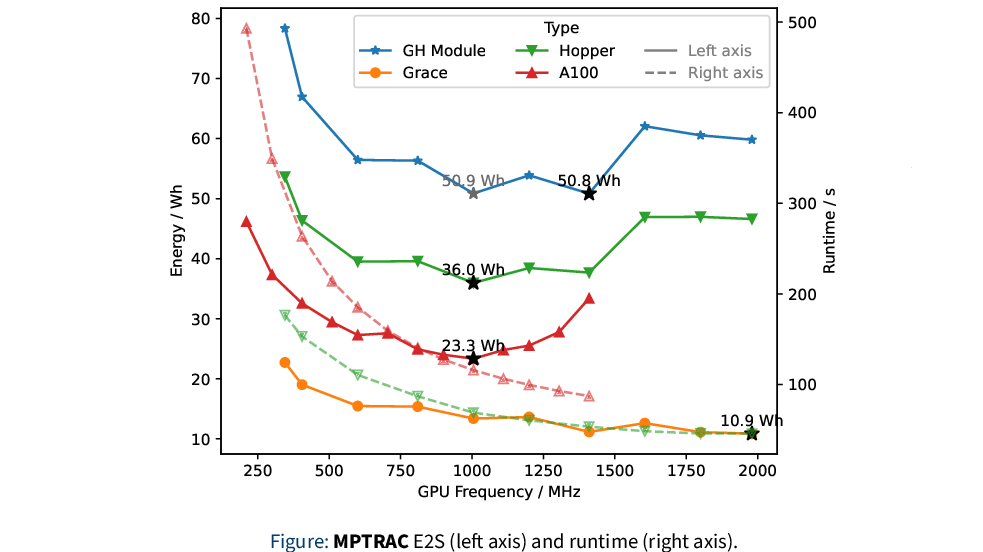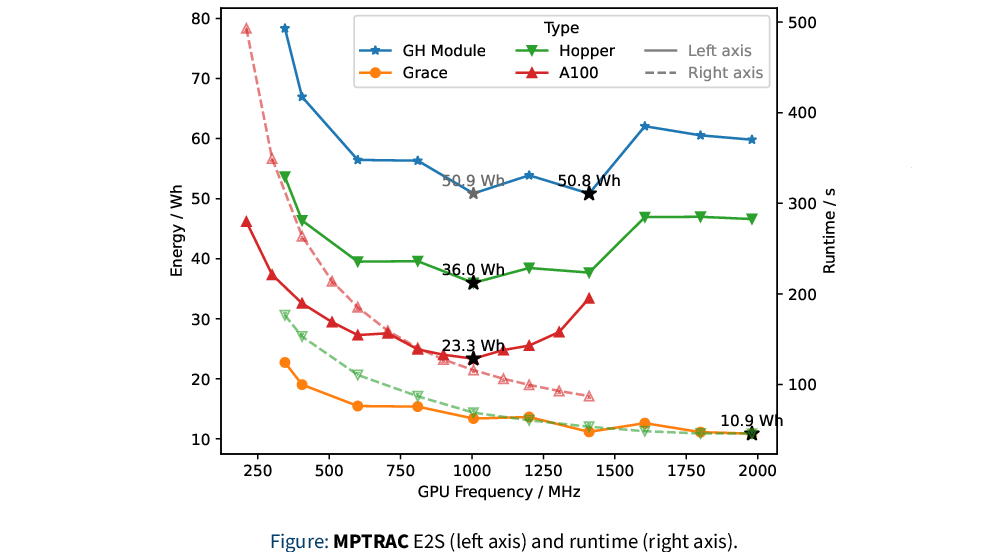

Towards JUPITER: Optimizing Energy Usage of Applications on GH200
Tuesday, June 10, 2025 3:00 PM to Thursday, June 12, 2025 4:00 PM · 2 days 1 hr. (Europe/Berlin)
Foyer D-G - 2nd floor
Research Poster
Optimizing for Energy and PerformancePerformance MeasurementPerformance Tools and Simulators
Information
Poster is on display and will be presented at the poster pitch session.
Energy efficiency is becoming increasingly critical in the exascale era, where even small improvements at the GPU or node level can translate into significant energy savings and cost reductions. JUPITER, the first exascale supercomputer powered by NVIDIA GPUs, underscores the importance of understanding energy behavior across diverse applications. However, energy evaluations that are both easy to use and provide comparable results are still not standard, creating a barrier to broader energy-aware computing practices.
This study, conducted under the JUPITER Research and Early Access Program (JUREAP), takes an important first step in addressing this challenge. By analyzing the energy usage of applications on JUPITER-like systems, it explores the potential of GPU clock adjustments to optimize energy consumption without requiring intrusive changes to application source code. The work employs scalable methods and tools designed to simplify energy evaluations while ensuring reproducibility across a wide range of workloads.
Three applications serve as representative cases: the High-Performance Linpack (HPL) synthetic benchmark, the MPTRAC atmospheric transport model, and SOMA, a Monte Carlo-based polymer simulation. These applications were chosen to demonstrate how energy efficiency varies across computational profiles, with HPL serving as a baseline, MPTRAC providing insights into large-scale atmospheric simulations, and SOMA highlighting challenges for memory-bound applications.
The methodology combines several tools to streamline energy measurement and analysis. A range-based approach ensures that energy consumption is tied to specific computation intervals, isolating the most relevant phases of execution. Many applications already utilize ranges for reporting runtimes, so this approach integrates seamlessly into existing workflows. Energy data is collected using jpwr, a non-invasive tool, while GPU frequency adjustments are managed via NVIDIA’s system management interface. This process is further automated through schedulers like SLURM, making it efficient and straightforward for users. All workflows are recorded within the exaCB CI/CD framework to enable reproducibility and scalability.
The initial results are promising. For HPL and MPTRAC, reducing GPU core frequencies led to significant energy savings with minimal impact on runtime. SOMA, being a memory-bound application, exhibited a different behavior, emphasizing the importance of tailoring energy optimization strategies to application-specific characteristics. These findings highlight the value of evaluating a diverse set of applications to develop a deeper understanding of energy efficiency in exascale systems.
This work achieves three key objectives: providing initial energy-to-solution results on a JUPITER-like system, enabling scalable studies across multiple applications, and outlining a path for future research into energy-aware computing. By addressing the challenges of energy measurement and simplifying workflows, this study paves the way for broader adoption of energy evaluation practices in HPC.
Visit this poster to learn how scalable and reproducible methods can provide meaningful insights into energy optimization for diverse applications, laying the groundwork for energy-efficient HPC practices in the exascale era.
Contributors:
Energy efficiency is becoming increasingly critical in the exascale era, where even small improvements at the GPU or node level can translate into significant energy savings and cost reductions. JUPITER, the first exascale supercomputer powered by NVIDIA GPUs, underscores the importance of understanding energy behavior across diverse applications. However, energy evaluations that are both easy to use and provide comparable results are still not standard, creating a barrier to broader energy-aware computing practices.
This study, conducted under the JUPITER Research and Early Access Program (JUREAP), takes an important first step in addressing this challenge. By analyzing the energy usage of applications on JUPITER-like systems, it explores the potential of GPU clock adjustments to optimize energy consumption without requiring intrusive changes to application source code. The work employs scalable methods and tools designed to simplify energy evaluations while ensuring reproducibility across a wide range of workloads.
Three applications serve as representative cases: the High-Performance Linpack (HPL) synthetic benchmark, the MPTRAC atmospheric transport model, and SOMA, a Monte Carlo-based polymer simulation. These applications were chosen to demonstrate how energy efficiency varies across computational profiles, with HPL serving as a baseline, MPTRAC providing insights into large-scale atmospheric simulations, and SOMA highlighting challenges for memory-bound applications.
The methodology combines several tools to streamline energy measurement and analysis. A range-based approach ensures that energy consumption is tied to specific computation intervals, isolating the most relevant phases of execution. Many applications already utilize ranges for reporting runtimes, so this approach integrates seamlessly into existing workflows. Energy data is collected using jpwr, a non-invasive tool, while GPU frequency adjustments are managed via NVIDIA’s system management interface. This process is further automated through schedulers like SLURM, making it efficient and straightforward for users. All workflows are recorded within the exaCB CI/CD framework to enable reproducibility and scalability.
The initial results are promising. For HPL and MPTRAC, reducing GPU core frequencies led to significant energy savings with minimal impact on runtime. SOMA, being a memory-bound application, exhibited a different behavior, emphasizing the importance of tailoring energy optimization strategies to application-specific characteristics. These findings highlight the value of evaluating a diverse set of applications to develop a deeper understanding of energy efficiency in exascale systems.
This work achieves three key objectives: providing initial energy-to-solution results on a JUPITER-like system, enabling scalable studies across multiple applications, and outlining a path for future research into energy-aware computing. By addressing the challenges of energy measurement and simplifying workflows, this study paves the way for broader adoption of energy evaluation practices in HPC.
Visit this poster to learn how scalable and reproducible methods can provide meaningful insights into energy optimization for diverse applications, laying the groundwork for energy-efficient HPC practices in the exascale era.
Contributors:
Format
On DemandOn Site

